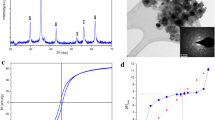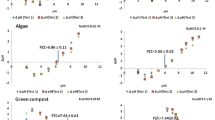Abstract
Adsorption of Mo(VI) on 2-0.2-μm size fraction of sodium-saturated kaolinite at 25 ± 2°C and at a constant pH of 7.00 ± 0.05 was studied. The kaolinite sample was pretreated to remove any surface oxide and hydroxide coatings. The initial concentrations of Mo in solution ranged from 1 to 11 mg/liter in a NaClO4 background electrolyte at a constant ionic strength of 0.09 ± 0.01. Calculations of speciation using the GEOCHEM computer program indicated that under experimental conditions Mo(VI) was mainly in the MoO42− form. The experimental conditions were also shown to fulfill the requirements for applying the Langmuir equation in interpreting adsorption data. The Langmuir parameter for the adsorption maximum, n°, and the affinity parameter, \(K_{MoO_{4^{2-}}-ClO_{4^{-}}}\) were computed to be 3.33 × 10−4 mole/ mole of adsorbent and 5.969 × 105, respectively. The large affinity parameter indicated that the Na-saturated kaolinite surface has a very high affinity for MoO42− ions relative to ClO4− ions.
Резюме
Исследовалась адсорбция Mo(VI) на фракции размером 2-0,2 μм каолинита, насыщен-ного натрием при температуре 25 ± 2°C и при постоянной величине рН равной 7,00 ± 0,05. Образец каолинита обработывался так, чтобы удалить все окисные и гидроокисные поверх-ностные покрытия. Начаьные концентрации Мо в растворе распределялись от 1 до 11 мг/литр в электролите NaClO4 при постоянной ионовой силе равной 0,09 ± 0,01. Вычисления количества новых вилов при помощи програмы ГЭОХЕМ указывали на то, что в этих экспериментальных условиях Mo(VI) находился в основном в форме MoO22−. Показано, что экспериментальные условия выполняли необходимые условия для использования уравнения Лангмюра для интерпретации данных адсорбции. Параметр Лангмюра для максимума адсорбции, n0, и параметр подобия, \(K_{MoO_{4^{2-}}-ClO_{4^{-}}}\), были вычислены как 3,33 × 10−4 моля/моль адсорбента и 5,969 × 105, соответственно. Значительный параметр подобия указывал на то, что поверхность каолинита, насыщенного Na, имеет очень высокое подобие для ионов MoO42− по отношению к ионом ClO4−. [E.G.]
Resümee
Es wurde die Adsorption von Mo(VI) an die 2-0,2 μm Fraktion von Na-gesättigtem Kaolinit bei 25 ± 2°C und einem konstanten pH von 7,00 ± 0.05 untersucht. Die Kaolinitprobe wurde vorbehandelt, um oxidische und hydroxidische Oberflächenbeläge zu entfernen. Die ursprünglichen Konzentrationen an Mo in der Lösung reichten von 1–11 mg/Liter in einer NaClO4 Elektrolytlösung mit einer konstanten Ionenstärke von 0,09 + 0,01. Die Berechnungen mittels GEOCHEM-Programm deuten darauf hin, daß unter den experimentellen Bedingungen Mo(VI) hauptsächlich als MoO42- vorlag. Es zeigte sich auch, daß die experimentellen Bedingungen so waren, daß sie die Anforderungen für die Anwendung der Langmuir-Gleichung bei der Interpretation der Adsorptionsdaten erfüllt haben. Der Langmuir-Parameter für das Adsorptionsmaximum, n°, und der Affinitätsparameter, \(K_{MoO_{4^{2-}}ClO_{4^{-}}}\), wurden, auf 3,33 × 10-4 Mole/Mole für den Adsorbenten bzw. mit 5,969 × 105 berechnet. Der große Affinitätsparameter deutete darauf hin, daß die Na-gesättigte Kaolinitoberfläche eine große Affinität für MoO42--Ionen im Vergleich zu ClO4--Ionen hat. [U.W.]
Résumé
On a étudié l’adsorption de Mo(VI) sur une fraction de kaolinite saturée de sodium de taille 2-0,2 μm à 25 ± 2°C at à un pH constant de 7,00 ± 0.05. L’échantillon de kaolinite avait été traité à l’avance pour enlever toutes couches oxides et hydroxides. Les concentrations de Mo initiales dans la solution s’étendaient d’l à 11 mg/litre dans un électrolyte d’arrière plan de NaClO4 à une force ionique constante de 0,09 ± 0,01. Des calculs de spéciation employant le programme GEOCHEM ont indiqué que sous les conditions expérimentales Mo(VI) était principalement dans la forme MoO42-. On a aussi montré que les conditions expérimentales ont satisfait les exigences pour appliquer l’équation de Langmuir dans l’interprétation des données d’adsorption. Le paramètre de Langmuir pour le maximum d’adsorption, n°, et le paramètre d’affinité, \(K_{MoO_{4^{2-}}-ClO_{4^{-}}}\), ont été computés être 3,33 × 10−4 mole/mole d’adsorbant et 5,969 × 105, respectivement. Le grand paramètre d’affinité a indiqué que la surface de kaolinite saturée de Na a une affinité très élevée pour les ions MoO42− relativement aux ions ClO4− [D.J.]
Similar content being viewed by others
References
Aubert, H. and Pinta, M. (1977) Trace Elements in Soils: Elsevier, New York, 395 pp.
Baes, C. F., Jr. and Mesmer, R. E. (1976) The Hydrolysis of Cations: Wiley, New York, 489 pp.
Barshad, I. (1951) Factors affecting the molybdenum content of pasture plants: I. Nature of soil molybdenum, growth of plants, and soil pH: Soil Sci. 71, 313–327.
Bernas, B. (1968) A new method for decomposition and comprehensive analysis of silicates by AA spectrometry: Anal. Chem. 40, 1682–1686.
Cotton, F. A. and Wilkinson, G. (1962) Advanced Inorganic Chemistry: Wiley-Interscience, New York, 959 pp.
Davies, C. W. (1962) Ion Association: Butterworths, London, 190 pp.
El Prince, A. M. and Sposito, G. (1982) Thermodynamic derivation of equations of the Langmuir type for ion equilibria in soils: Soil Sci. Soc. Amer. J. 45, 277–282.
Hingston, F. J. (1981) A review of anion adsorption: in Adsorption of Inorganics at Solid-Liquid Interfaces, M. A. Anderson and A. J. Rubin, eds., Ann Arbor Science, Ann Arbor, Michigan, 51–90.
Jones, L. H. P. (1957) The solubility of molybdenum in simplified systems and aqueous soil suspensions: J. Soil Sci. 8, 313–327.
Jorden, R. M. and Meglen, R. R. (1973) Aqueous release of molybdenum from non-point and point sources: in Trace Substances in Environmental Health VII, D. D. Hemphill, ed., Univ. Missouri, Colombia, Missouri, 105 pp.
Kopp, J. F. and Kroner, R. C. (1970) Trace elements in waters of the United States. Oct. 1, 1962–Sep. 20, 1967: U.S. Dept. Interior, Fed. Wat. Poll. Control Adm., Div. Poll. Sur. Cincinnati, Ohio, 32 pp.
Mattigod, S. V. and Sposito, G. (1979) Chemical modeling of trace metal equilibria in contaminated soil solutions using the computer program GEOCHEM: in Chemical Modeling in Aqueous Systems, ACS Symp. Ser. 93, Amer. Chem. Soc., Washington, D.C., 837–856.
Sposito, G. (1979) Derivation of the Langmuir equation for ion exchange reactions in soils: Soil Sci. Soc. Amer. J. 43, 197–198.
Sposito, G. (1983) The chemical forms of trace metals in soils: in Applied Environmental Geochemistry, I. Thornton, ed. Academic Press, London, (in press).
Vlek, P. L. G. and Lindsay, W. L. (1977) Molybdenum contamination in Colorado pasture soils: in Molybdenum in the Environment, W. R. Chappell and K. K. Peterson, eds., 2, Marcel Dekker, New York, 619 pp.
Author information
Authors and Affiliations
Rights and permissions
About this article
Cite this article
Phelan, P.J., Mattigod, S.V. Adsorption of Molybdate Anion (MoO42−) by Sodium-Saturated Kaolinite. Clays Clay Miner. 32, 45–48 (1984). https://doi.org/10.1346/CCMN.1984.0320106
Received:
Accepted:
Published:
Issue Date:
DOI: https://doi.org/10.1346/CCMN.1984.0320106




